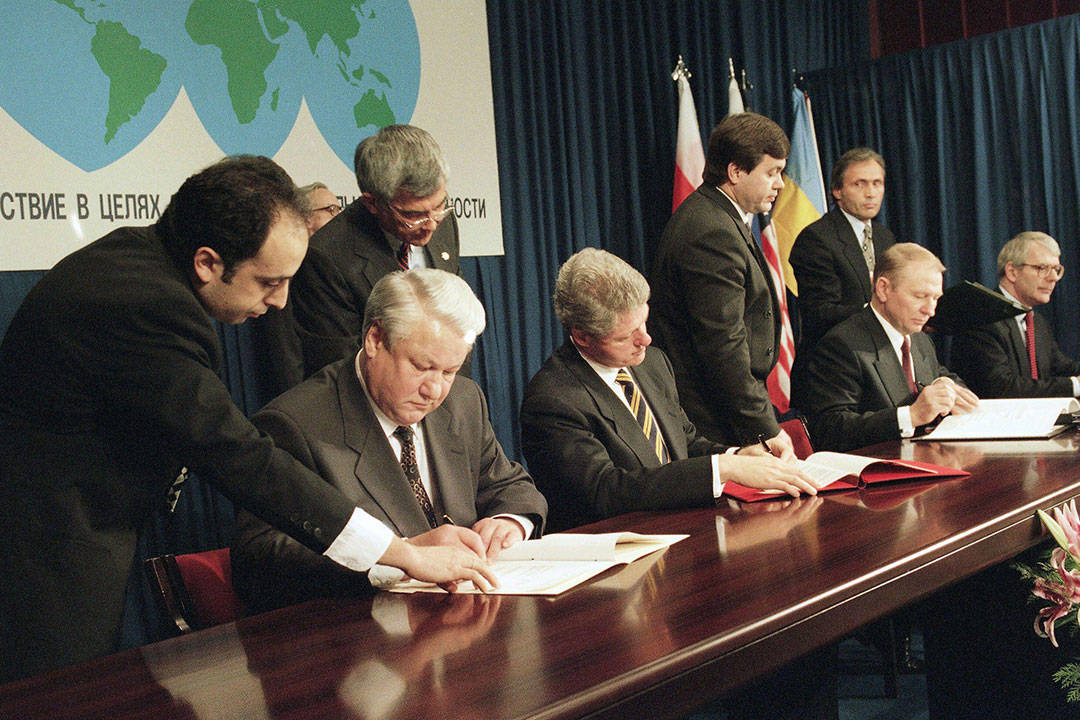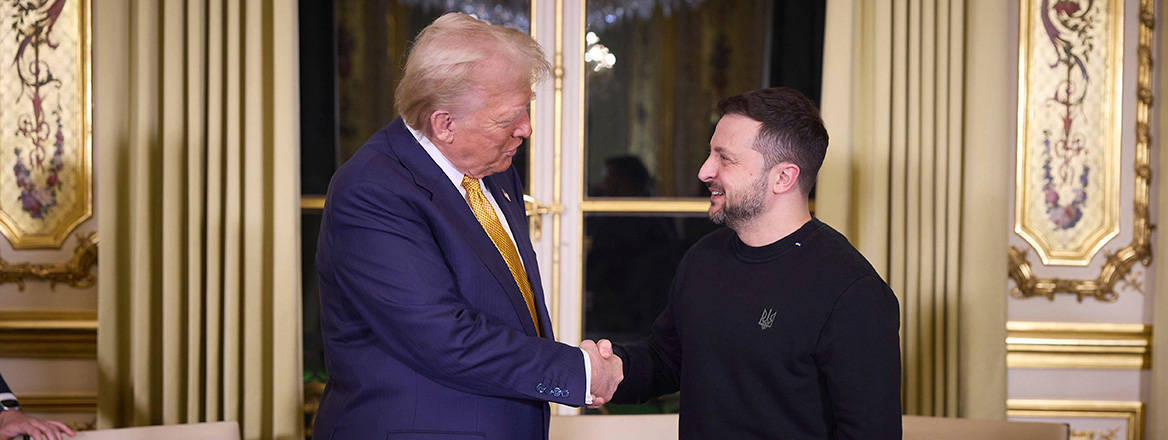From Budapest Memorandum to Ukraine Compact: A Conundrum of Guarantees
Ukraine's evolving search for security guarantees reflects hard-learned lessons from the Budapest Memorandum, with bilateral agreements offering hope yet raising critical uncertainties.
Since gaining independence, Ukraine has been engaged in a constant search for security guarantees. After the signing of the so-called Budapest Memorandum in 1994, there was a misplaced hope that by rejecting its nuclear arsenal, the country would receive protection. While some naivety was present in 1994, when none of the big states – including Russia – was seen as a potential threat, mistakes with long-term consequences were made – namely, accepting the term ‘assurances’ and the non-legally-binding form of the memorandum. Moreover, there was an element of self-deception on the part of many in Ukraine, as the authentic translation in Russian and Ukrainian was titled ‘Memorandum on security guarantees‘, despite the English version explicitly saying ‘Memorandum on security assurances‘.
The events of 2014 and later 2022 clearly demonstrated the necessity of seeking concrete security partnerships and guarantees. Ukraine has always seen NATO membership as the best solution. However, in times of war, finding a proper framework is even more difficult than in times of peace. If NATO countries had not been ready to accept Ukrainian Euro-Atlantic integration when Russia was seen as a partner, since 2014, any request for NATO membership has been labelled as an attempt to escalate the situation.
While reacquiring nuclear weapons has never been a real option for Ukraine, a discussion has thus emerged on what other options Ukraine may have.
The political and expert debate regarding the need for bilateral security agreements or alliances started long ago, but these were always seen as a temporary or additional option rather than an alternative to NATO membership. Arrangements such as LITPOLUKRBRIG or the Lublin Triangle were a prototype for future initiatives, part of a proposed strategy of small alliances as temporary measures that would enhance security arrangements and allow better interoperability.
September 2022 saw the publication of the Kyiv Security Compact, with recommendations prepared by the Office of the President of Ukraine together with international high-level experts. It presented a complicated framework of multilateral and bilateral agreements with key actors, supported by EU and NATO membership for Ukraine and the development of its own capabilities, but it lacked a real answer as to what the agreements should include except defence investments and training, NATO membership and unknown commitments from Ukraine’s partners.
One of the major additions to the agreements compared to the previous security arrangements is a significant focus on defence industry development and investment in Ukraine's production
Still, it triggered negotiations with many partners regarding the possibility of concluding bilateral agreements. What started with the G7 Vilnius Declaration during the NATO Summit in 2023 has resulted in 28 agreements as of January 2025. All NATO member states except Albania, Bulgaria, Hungary, North Macedonia, Slovakia, and Turkey have signed bilateral agreements, as have Japan and the EU. North Macedonia started negotiations in June 2024, Montenegro in August 2024, and Bulgaria in October 2024.
Going into negotiations, one of Ukraine's main considerations was to avoid the mistakes of the Budapest Memorandum – from the exaggerated expectations to its inherent impotence. Still, the new agreements retain some of the same questions. As the agreements are not treaties, they do not require ratification by the respective countries’ parliaments. Many diplomats involved emphasised that this was done intentionally to speed up the process and to prevent opponents from blocking the signing. However, such a format implies high political risks, because in the end, it makes it easier for the next president or prime minister to cancel the agreement, or to insist that the document is not legally binding.
Also, they do not provide ‘guarantees’ but ‘commitments’, which is connected with the question of the probability of the agreements’ realisation and the willingness to defend Ukraine in case of further military developments. The reason the agreements have not become multilateral is that each country was ready for a different extent of commitments. Some countries clearly indicated a financial package behind the agreement (such as the UK, Norway, Sweden, and Spain), while others emphasised capabilities pledges – for example, the UK has pledged support for maritime capabilities, Poland support for armoured capability, Japan support for IT, Lithuania support for demining capabilities, Spain support for air defence, and Romania aims to deepen mutually beneficial cooperation to enhance security in the Black Sea region.

Regarding future NATO membership, the wording of the agreements varies. Some agreements clearly indicated that NATO membership for Ukraine would make an effective contribution to peace and stability in Europe, and that the signatories would strengthen joint efforts to support Ukraine's accession to NATO (the UK, Sweden, Spain, Norway, Lithuania). Others just stated that ‘Ukraine's future is in NATO’ (Slovenia) or gave a clear indication that NATO membership for Ukraine is in the strategic interest of both countries (Poland). Most of the agreements merely reaffirmed support for reforms aimed at realising Ukraine's European and Euro-Atlantic aspirations, including towards EU and NATO membership.
One of the major additions to these agreements compared to the previous security arrangements is a significant focus on defence industry development and investment in Ukraine's production. Partially, this is seen as a long-term investment in European security and capabilities, as the first year of the Russia–Ukraine war proved the unpreparedness of the European industrial complex for the scale and scope of wartime requirements, as well as a serious dependence on the US. The development of particular capabilities also clearly indicates a long-term investment in Ukraine's defence.
Ukraine anticipated the bilateral agreements to be like the UK ones with Sweden and Finland before their full integration into NATO, but with long-terms plans and perspectives. Meanwhile, many partners considered bilateral agreements with Ukraine as a temporary substitute for full integration into the Alliance. However, the positioning of the bilateral agreements as supplements to NATO membership has been clearly articulated by the Ukrainian side, including in President Volodymyr Zelenskyy's Victory Plan.
The important part in each of the bilateral agreements is a chapter on ‘Cooperation / Consultations in the event of a future Russian armed attack’. In all cases, this means specifically an attack against Ukraine, as opposed to a NATO ally. The wording of this chapter is almost identical in each agreement and comprises three main points, which are quite vague:
- At the request of either Participant, the Participants will consult bilaterally or through other mutually acceptable channels within 24 hours to determine appropriate next steps;
- In those circumstances and acting within its means and capabilities, in accordance with its respective legal, constitutional requirements and with international and European Union's rules and law, the country would provide Ukraine, as appropriate, with swift and sustained political, security, military, humanitarian and economic assistance;
- In order to ensure the widest and most effective collective response to future armed attack, the Participants may amend these provisions so as to align them with any mechanism that they may subsequently agree with other international partners.
The positive aspect of these agreements is that, finally, Ukraine is no longer seen exclusively as a security recipient. The bilateral nature of the agreements is demonstrated not only in the signature line but also in the commitments that Ukraine reciprocally makes to help NATO member states. In most of the agreements, this is manifested in information exchange and training, joint defence production, and intelligence and counterintelligence cooperation, but some went further. The US–Ukraine agreement states that ‘Any future aggression or threat of aggression against the sovereignty, independence, and territorial integrity of either Party would be a matter of grave concern to the other Party’. The Lithuania–Ukraine agreement has a separate chapter on Ukraine's commitments, including: ‘The Parties will seek to ensure that Ukraine’s military capabilities are at such a level that, in the event of external military aggression against Lithuania, Ukraine is able to provide effective military assistance’. The Poland–Ukraine agreement focuses on pre-war preparations: ‘The Participants acknowledge that in the context of the current Russian war of aggression, Ukraine has gained significant experience and expertise that can contribute to the continued modernisation of the Polish Armed Forces.’ Nevertheless, the predominant share of the commitments are those made by partners to help Ukraine. On reading the texts, one can have the impression that such an imbalance is not because of Ukraine's unwillingness but because of the partners' confidence that the real threat of aggression is not immediate and that their NATO umbrella is sufficient.
Each signed bilateral agreement is a gentleman’s agreement that is entirely dependent on the goodwill of individual countries
Still, it is questionable whether it is a positive or negative decision to include other areas aside from defence and military issues in the security agreements. The protection of critical infrastructure, information and cyber security long ago became parts of the hard security and NATO agenda. At the same time, combatting organised crime; illicit financing; sanctions; Russia's accountability for acts of aggression and war crimes; fiscal, recovery and reconstruction support; humanitarian aid; anti-corruption; judiciary reform; and even cultural heritage might be better as topics for separate agreements so as not to diffuse attention from the main objective of the security agreements.
A year after the G7 Declaration, in July 2024, the Ukraine Compact was signed. The document was seen by its creators as a foundation for greater coordination among those that had signed and possible future bilateral agreements. It was stated that it is aimed at accelerating collective efforts to meet Ukraine's comprehensive security needs, as outlined in the Joint Declaration and in the security agreements and arrangements each of the signatories has completed with Ukraine. The compact also de facto became an attempt to unite EU and NATO efforts in support of Ukraine's defence. Still, it has a much softer formulation regarding future NATO membership than many of the bilateral agreements - ‘Compact Signatories plan to take these commitments forward while Ukraine pursues its pathway towards future membership in the EU, NATO, and the broader Euro-Atlantic community’.
The bilateral security agreements have raised a lot of questions. Will they secure military support for Ukraine even if the US stops providing it? Are they a substitute for NATO membership for Ukraine? Are they merely an upgraded version of the Budapest Memorandum with a big package of material support, or are they a legalisation of the military support Ukraine has been receiving? How much are they dependent on political will in the signatory states? Will these agreements help to win the war or prevent the next one?
These are just a few questions in a long list. Some of them would be answered with the action plans that are expected for implementation. Some would be answered by the extent of implementation (defence industry investments, training, intelligence exchange and so on). A few points remain unknown. The issue of political will is especially problematic in times of war. Each signed bilateral agreement is a gentleman’s agreement that is entirely dependent on the goodwill of individual countries. Moreover, a complex of such agreements introduces an overlapping puzzle of security commitments without any concomitant guarantees.
© Hanna Shelest, 2025, published by RUSI with permission of the author
The views expressed in this Commentary are the author’s, and do not represent those of RUSI or any other institution.
For terms of use, see Website Ts&Cs of Use.
Have an idea for a Commentary you’d like to write for us? Send a short pitch to commentaries@rusi.org and we’ll get back to you if it fits into our research interests. Full guidelines for contributors can be found here.
WRITTEN BY
Dr Hanna Shelest
- Jim McLeanMedia Relations Manager+44 (0)7917 373 069JimMc@rusi.org




